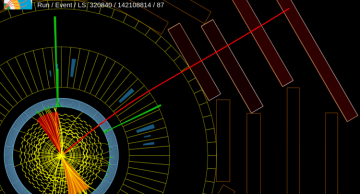The Standard Model of Particle Physics is the theory that physicists use to describe elementary particles’ fundamental interactions. The Standard Model was developed over many decades. It has been able to predict experimental observations with…
News
|
fblekman |
Physics
The CMS Collaboration has released a new search for leptoquarks, a hypothetical particle that would be the "missing link" between quarks and leptons. The result has been submitted to the journal Physics Letters B.
All known visible matter that…
|
fbaldass |
Physics
What if new particles modify the behaviour of existing particles, but by only a little bit? In a new result, CMS physicists search for new physics using a technique called Effective Field Theory to study the top quark in a "toy universe".…
|
fblekman |
Physics
Eight years ago in 2012, at the largest International Conference on High Energy Physics, the discovery of a new particle carefully coined as Higgs boson-like was announced by the ATLAS and CMS Collaborations. They had seen an excess in data over…
|
fblekman |
Physics
A new result by the CMS collaboration accepted by the journal Physical Review Letters demonstrates for the first time that top quarks are produced in nucleus-nucleus collisions. At the same time, this also demonstrates the capability of the CMS…
|
fblekman |
Physics
It is the dream of all particle physicists to find a new particle or to reveal a new fundamental force. In 2012 this dream came true when the big CERN experiments ATLAS and CMS discovered the Higgs particle, predicted by theorists decades ago. Other…
|
fblekman |
Physics
A new result released by the CMS Collaboration presents the first evidence of the Higgs boson interacting with the muon.
The standard model of particle physics describes all the known fundamental particles in the Universe. A mystery of the standard…
|
fblekman |
Physics
In 2012 the ATLAS and CMS collaborations discovered a boson with a mass of 125 GeV, i.e. approximately 125 times the mass of the proton, in proton-proton collisions at the CERN LHC. This has marked a milestone in high energy physics, as this…
|
fblekman |
Physics
Measuring the interaction between the Higgs boson and other particles is essential to understand if the particle behaves consistently with predictions. For the International Conference of High Energy Physics 2020, the CMS experiment has released…
|
fblekman |
Physics
A question researchers at the LHC are trying to answer is whether the properties of the Higgs boson are as predicted by the standard model. One way to do this is to look for extremely rare decays of the Higgs boson, as physicists in the CMS…
|
fblekman |
Physics
The Higgs boson is an extremely rare particle. At the Large Hadron Collider (LHC), where bunches of protons collide at more than 99.9999% of the speed of light up to forty million times per second, a Higgs is produced around once per second. The…
|
fblekman |
Physics
In 2012 the CMS and ATLAS Collaborations announced the discovery of a new particle, that seems mostly consistent with the Higgs boson as predicted by the Standard Model. To understand if that is actually the case, physicists in the CMS…












